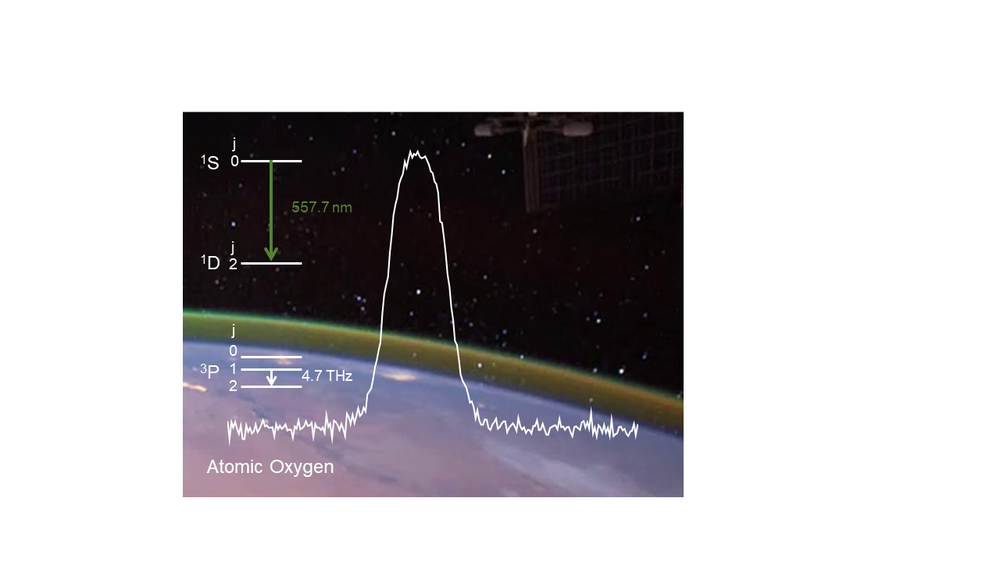An airborne stratospheric observatory measures the concentration of atomic oxygen directly for the first time



- GREAT is the first instrument to directly measure the concentration of atomic oxygen in the mesosphere and lower thermosphere.
- The first measurements were conducted during a SOFIA flight along the west coast of the USA.
- Focus: Space, terahertz research, sensor systems
The German REceiver for Astronomy at Terahertz frequencies (GREAT) spectrometer on board the Stratospheric Observatory for Infrared Astronomy (SOFIA) has enabled direct, high-resolution spectral measurements of the concentration of atomic oxygen in the mesosphere and lower thermosphere regions of Earth's atmosphere. Scientists from the German Aerospace Center (Deutsches Zentrum für Luft- und Raumfahrt; DLR), the Max Planck Institute for Radio Astronomy (MPIfRA) and the University of Cologne are investigating a new approach to making direct measurements in the terahertz range, preparing the way for the development of future space instruments. The results have now been published in the Nature journal Communications Earth & Environment.
Atomic oxygen is one of the main components of the mesosphere (the middle of the five layers of Earth's atmosphere) as well as the lower part of the thermosphere. This oxygen-rich region of the atmosphere extends from an altitude of approximately 80 kilometres up to over 300 kilometres. There, the oxygen content regulates photochemical processes and the Earth-atmosphere energy balance; it is an important indicator of dynamic shifts in the atmosphere. The GREAT terahertz spectrometer has enabled the concentration of atomic oxygen to be measured directly and at a high spectral resolution for the first time.
Various methods had been used for this purpose in the past. For example, atomic oxygen concentration has been determined indirectly based on observations of sky glow at night or measurements of molecules involved in photochemical processes with atomic oxygen. Scientists made these calculations using several satellite instruments. However, these methods are indirect and based on models and assumptions. "The findings do not always agree, especially when they are obtained using different instruments," says Heinz-Wilhelm Hübers, Head of the DLR Institute of Optical Sensor Systems. "Thanks to the GREAT terahertz spectrometer, we have been able to investigate an alternative approach that allows us to conduct direct measurements." GREAT’s high spectral resolution enables us to make high-precision measurements of the 4.7 terahertz transition, from which altitude profiles can be derived for the concentration of atomic oxygen. The first spectrally resolved measurements for this transition were revealed during a SOFIA flight in January 2015 along the west coast of the USA. These data are a byproduct of astronomical observations in the same frequency band. "The measurements with GREAT have shown that our measurements agree well with atmospheric models derived from satellite observations," says Hübers.
Developing terahertz technology for future space instruments
Based on the technology used in the GREAT instrument, future high-resolution terahertz spectrometers may also be suitable for use in space. The European Space Agency (ESA) is actively promoting this advancement of terahertz technology for future satellite missions.
About SOFIA
The Stratospheric Observatory for Infrared Astronomy (SOFIA) is a joint project of the German Aerospace Center (Deutsches Zentrum für Luft- und Raumfahrt; DLR) and the National Aeronautics and Space Administration (NASA). The German contribution to the project is managed by the DLR Space Administration, using funds provided by the German Federal Ministry for Economic Affairs and Energy, the Federal State of Baden-Württemberg and the University of Stuttgart. The scientific operations are coordinated by the German SOFIA Institute (Deutsches SOFIA Institut; DSI) at the University of Stuttgart in Germany and the Universities Space Research Association (USRA) in the USA.
About GREAT
The German REceiver for Astronomy at Terahertz Frequencies (GREAT / upGREAT) was developed and built by a consortium of German research institutes (the Max Planck Institute for Radio Astronomy (MPIfRA), Bonn, and KOSMA/the University of Cologne, in collaboration with the DLR Institute for Optical Sensor Systems, Berlin, and the Max Planck Institute for Solar System Research, Göttingen). The development of the instrument is financed with funds from the participating institutes, the Max Planck Society, the German Research Foundation (Deutsche Forschungsgemeinschaft; DFG) and DLR.
